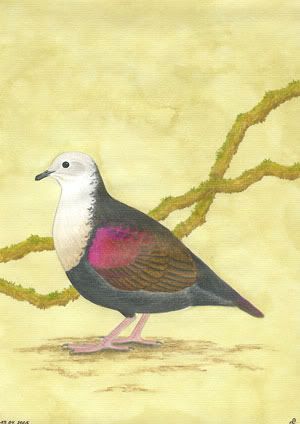|
|
Post by Melanie on Oct 29, 2005 22:25:15 GMT
A new species of ground dove in the genus Gallicolumba is described from abundant material from late Pleistocene to Holocene age deposits of natural and midden derivation on Henderson Island in the Pitcairn Group, South Pacific Ocean. Osteological characters suggest that it was most closely related to G. stairi and G. rubescens. Relatively enlarged leg elements and reduced wing elements suggest that this dove was facultatively flightless. www.rsnz.org/publish/jrsnz/2003/041.php |
|
|
|
Post by Melanie on Oct 29, 2005 22:27:46 GMT
Before the Polynesian settlement of Henderson between 800 and 1600 AD, two other dove species, a Gallicolumba ground-dove and a Ducula pigeon coexisted with the Fruit Dove. www.stamps.gov.pn/wwf+2.htm |
|
|
|
Post by Melanie on Oct 29, 2005 22:34:39 GMT
Order COLUMBIFORMES Family COLUMBIDAE Gallicolumba sp. Unknown Ground-dove MATERIAL: NISP = 1, MNI = 1; 1 tarsometatarsus (proximal end) (388744). REMARKS: This fragmentary specimen represents a species of Gallicolumba rather than Ducula or Ptilinopus because of these characters: tuberositas musculo tibialis cranialis abuts medial foramen vascularium groximalium (located more distad in Ducula and Ptilinopus); medial foramen vascularium proximalium smaller; in medial aspect, proximal margin of shaft thinner; in plantar aspect, medial margin of shaft more smoothly recurved; sulcus Flexorius longer, sharper. USNM 388744 is larger than the tarsometatarsus oh" Gallicolumba erythroptera, which occurs in the Tuamotu Group today and has been extirpated in the Cook and Society Islands. The Henderson specimen is much larger than in G. * of the Marquesas, but smaller than in the extinct Gallicolumba new species 2 of the Marquesas, Society, and Cook Islands (Steadman 1989). USNM 388744 resembles the tarsometatarsus of G. erythroptera and G. rubescens more than that of G. new species 2 in the smoothly curved, shallow proximomedial margin of the shaft, the presence of a lateral foramen vascularium groximalium, and the shallower fossa infracotylaris dorsalis (Steadman in press). This is the southeasternmost record for any species of Gallicolumba. The nearest congener is S. erythroptera, which occurs on certain islands in the southeast portion of the Tuamotu Group, about 1000 km west-northwest OF Henderson. source: www.botany.hawaii.edu/faculty/duffy/arb/321-329/325.pdf |
|
|
|
Post by another specialist on Oct 31, 2005 11:00:59 GMT
This species was based on the discovery of one bone - amazing that you can say its new and not of a known species already recorded
|
|
Deleted
Deleted Member
Posts: 0
|
Post by Deleted on Feb 2, 2006 14:43:05 GMT
|
|
|
|
Post by another specialist on Feb 14, 2006 21:08:30 GMT
great file thanks noisi for finding it plus great to see its been named at last.
|
|
|
|
Post by another specialist on Aug 17, 2007 21:27:23 GMT
|
|
|
|
Post by another specialist on Aug 17, 2007 21:39:44 GMT
Henderson Island Ground-dove Gallicolumba sp thread has been renamed Gallicolumba leonpascoi |
|
|
|
Post by another specialist on Aug 17, 2007 21:47:35 GMT
|
|
|
|
Post by another specialist on Mar 22, 2008 22:40:55 GMT
Henderson Island Ground-dove Hi ! Descriped by subfossil bonefindings from Henderson Island / Pitcairn-Group:  Bye Alex  www.flickr.com/ www.flickr.com/ |
|
|
|
Post by another specialist on Jul 27, 2008 20:42:17 GMT
|
|
|
|
Post by another specialist on Sept 9, 2008 20:55:12 GMT
|
|
|
|
Post by surroundx on Feb 8, 2015 13:25:30 GMT
|
|